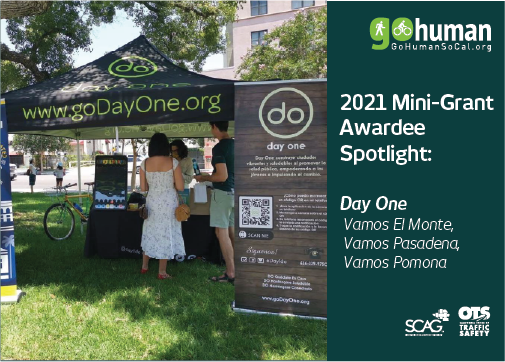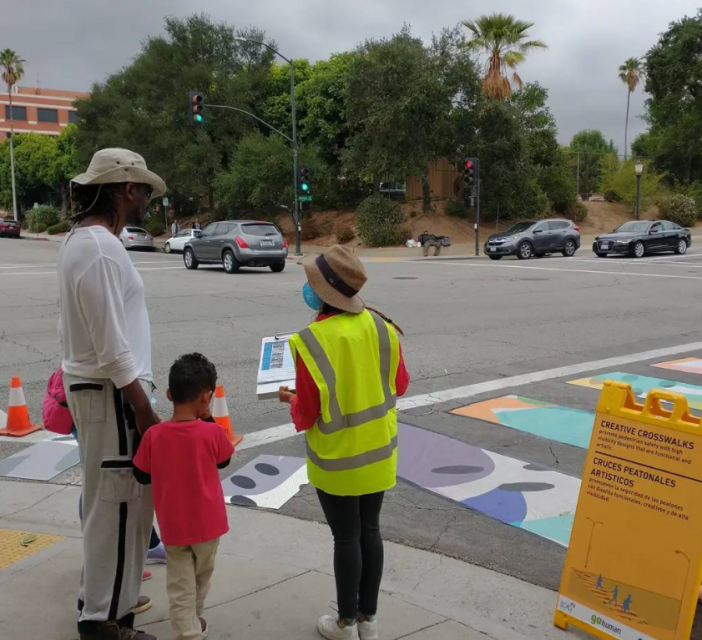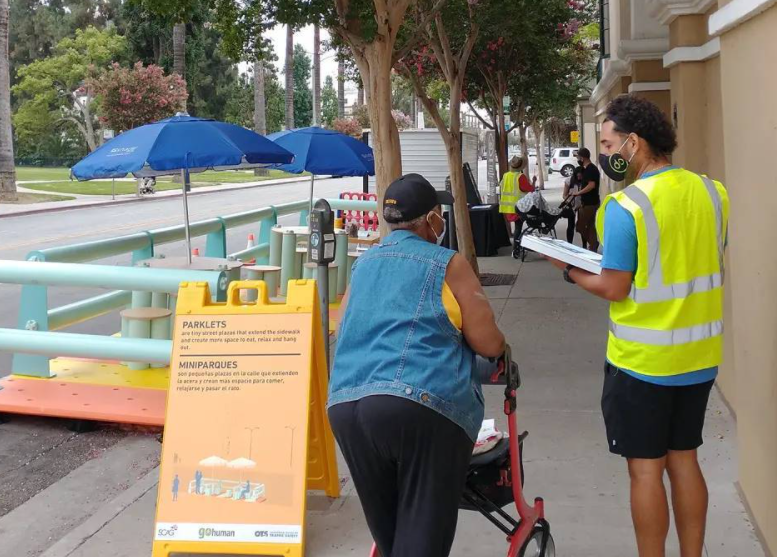Mini-Grant Awardee Spotlight
Day One is Creating Safer Streets in El Monte, Pasadena, and Pomona
Working with community members to identify intersections that are unsafe, unwalkable, and in need of interventions to address community concerns, Day One is working in two phases to implement projects in Vamos El Monte, Vamos Pasadena, and Vamos Pomona. Both phases include community engagement activities and participation. During phase two, Day One will work with community members in El Monte, Pasadena, and Pomona in the implementation of a temporary, community-driven pop-up event and will assess efficacy and recommend long-term solutions to decision-makers.
Day One shared the details of how they used effective community engagement strategies to assist these communities in tackling their traffic safety concerns through their Go Human Community Streets Mini-Grant project.
Describe how your Go Human mini-grant project helped to bring the traffic safety concerns of your community to light.
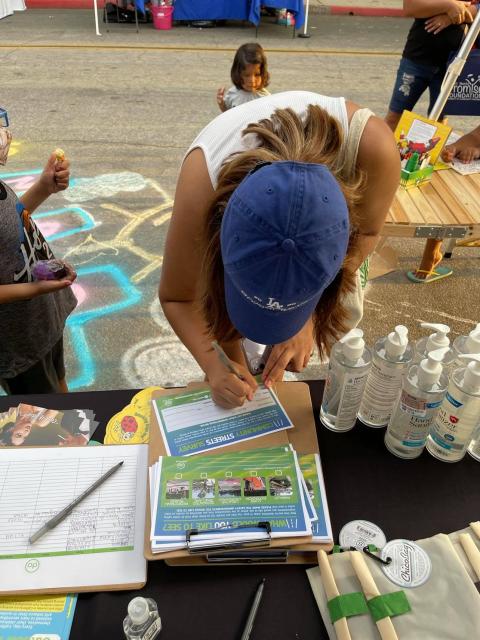 Day One: The City of Pomona is currently going through a Complete Streets Policy process with the award of a $700,000 grant from SCAG. Through our mini-grant project called “Vamos Pomona” we have been able to collaborate with city staff and local leaders to connect them with community-specific traffic safety concerns. Our community streets surveys, which have been administered both in paper form and digital form in Spanish and English are helping capture community concerns, elevate the need for improvements to address traffic safety concerns and igniting the conversation in Pomona about how street improvements translate to addressing traffic safety concerns.
Day One: The City of Pomona is currently going through a Complete Streets Policy process with the award of a $700,000 grant from SCAG. Through our mini-grant project called “Vamos Pomona” we have been able to collaborate with city staff and local leaders to connect them with community-specific traffic safety concerns. Our community streets surveys, which have been administered both in paper form and digital form in Spanish and English are helping capture community concerns, elevate the need for improvements to address traffic safety concerns and igniting the conversation in Pomona about how street improvements translate to addressing traffic safety concerns.
Our organization has a history of working to address traffic safety concerns in the City of El Monte through policy, systems and environmental changes for over 6 years, including the adoption of the city’s Complete Streets Policy, a Vision Zero resolution and leading a multi-district Walk to School Day. Through this Go Human mini-grant, we have been able to bring these policy, systems and environmental changes into a tangible project that will impact the way that residents interact with their streets, crosswalks, sidewalks and bike lanes. We are also able to collect quantitative data on exactly what traffic safety improvements residents would like to see in their streets, to be able to share that with local leaders, decision-makers and city staff.
Day One has been working hand in hand with the City of Pasadena to increase traffic safety throughout the city. Through this Go Human mini-grant, we have been able to connect and listen to local concerns while collecting quantitative data on exactly what traffic safety improvements residents would like to see in their streets, to be able to share that with local leaders, decision-makers and city staff.
How was this grant program different than others your organization has been involved with?
Day One: As an organization, advocating for safe streets and walkable neighborhoods has been at the core of our environmental prevention strategies model for creating healthier, vibrant cities. Community engagement has also been a central focus of the work that we do. This project blends advocacy with direct, intentional community engagement, which is the type of work that we do. This Vamos Pomona, Pasadena and El Monte program funded through Go Human allows us to narrow our focus to identify and pinpoint specific issue areas that residents deal with on a daily basis. Our community streets survey asks residents in their respective cities to share problem areas with us, so that we can map, track and quantify community priority areas and then share with decision-makers and city staff. Too often, we hear residents say they don’t feel safe walking home or walking their kids to school, or other traffic safety concerns – with this program, we are taking the guesswork out for decision-makers.
What would you say proved to be the most effective strategies for engaging the community?
Day One: The most effective strategies for engaging the community were: employing a mixture of low-tech and high-tech approaches, meeting the community where they are, and building on existing partnerships and events. To complete our surveys and get the word out about our Vamos Pomona, Pasadena and El Monte project, we used low-tech approaches like paper surveys, phone calls, tabling events and canvassing. High-tech approaches include employing social media to collect surveys, share the kit-of-parts temporary improvements through visual posts and use QR codes to make survey collecting streamlined and simple.
Another set of strategies that were effective were meeting the community where they are by not relying on community members to come to us and building on existing partnerships and events – this includes food distribution sites, farmer’s market, art walks, community events and partner meetings, but it also included sharing the survey with strategic community partners who have a vested interest in street safety improvements like Clean & Green Pomona, Pomona Valley Runners, Active SGV and the Latino/a Roundtable.
What role did community partnerships play in the success of your Go Human mini-grant project?
Day One: As mentioned above, community partners played an important role in the success of our mini-grant; either directly by helping us share the survey or information about the community streets program, or serving as liaisons between target populations and our organization. They will also help us in ensuring that our pop-up events are successful.
What creative methods did your organization use in the promotion and messaging of your Go Human mini-grant project?
Day One: To promote and get messaging across to the communities we work in, we have been employing a number of creative methods, including cross-promoting within our various programs within our organization that are conducting community outreach, conducting pop-up outreach events at art walks, farmer’s markets and other existing community events. We also have canvassed transportation/pedestrian hubs and posted flyers with survey QR codes. To catch the attention of residents who may not view street safety as a priority, we highlight the multi-benefits of street improvements such as neighborhood revitalization and improving neighborhood character and sense of community. We also use vivid, descriptive pictures of street improvements to start the conversation about safety infrastructure improvements like parklets and creative crosswalks in their cities.
Describe the level of support from local government and/or community leaders in the implementation of your Go Human mini-grant project.
Day One: Overall, the city staff and elected officials in the cities we are working in have a high-level of support for the implementation of this project. We are assisting them in engaging community residents and identifying issue areas that need investment and improvement. In Pomona, city staff is undergoing a Complete Streets Policy and sees this work as complementary to their efforts, and city council members have expressed special interest in improving traffic safety and pedestrian safety, as well as walkability and addressing the environmental impacts from cars and the lack of pedestrian infrastructure. Staff is working with city staff in all three cities to increase community outreach and engagement efforts.
How did you use community input to help shape your Go Human mini-grant project objective?
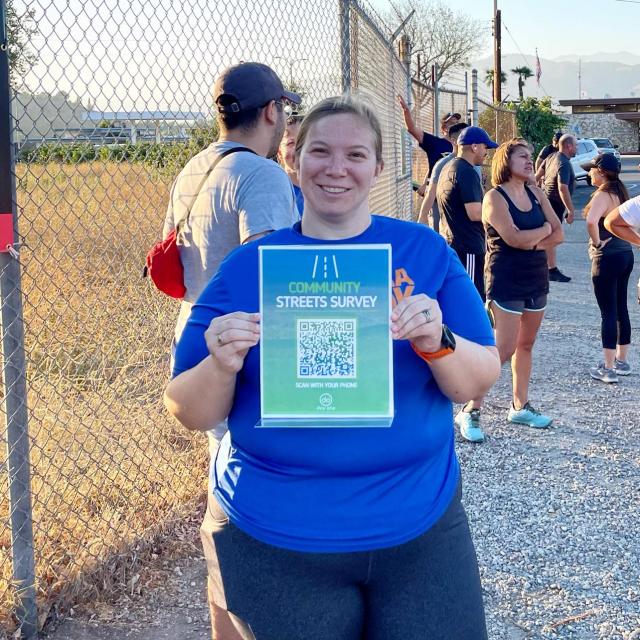 Day One: Community input was the main driver of our project objective. The mini-grant was written so that the pop-up event is community-led and eventually, the improvements that come from the data collection from surveys will be community-led. Our project was designed in 2 phases. The first phase includes collecting community input by surveying community members, the second phase includes implementing a pop-up project using the collected data from community members from phase 1, but also will include community members in the planning process. We also plan on conducting another survey at the pop-up event to ask residents their attitudes towards the infrastructure improvement that is modeled in the pop-up event.
Day One: Community input was the main driver of our project objective. The mini-grant was written so that the pop-up event is community-led and eventually, the improvements that come from the data collection from surveys will be community-led. Our project was designed in 2 phases. The first phase includes collecting community input by surveying community members, the second phase includes implementing a pop-up project using the collected data from community members from phase 1, but also will include community members in the planning process. We also plan on conducting another survey at the pop-up event to ask residents their attitudes towards the infrastructure improvement that is modeled in the pop-up event.
What new issues or concerns did you discover through the implementation of your Go Human mini-grant project?
Day One: Throughout the process of conducting community outreach in the form of surveys and speaking with members of the public in the communities of Pomona, Pasadena and El Monte, we have found that there are a number of complex issues that extend further than making infrastructure improvements. These issues include: addressing public safety, both perceived and actual; addressing environmental impacts that create barriers for active transportation such as heat island effect, lack of tree canopy coverage and the impacts of climate change/unpredictable weather patterns; addressing stigma behind walking, biking and public transportation; environmental and social justice issues that create barriers for pedestrians and cyclists such affordability of bikes and public transportation, the prioritization of the typical work day in public transportation and lastly, issues around connectivity, inaccessible/incompatible public transportation routes and first mile/last mile challenges.
What challenges did Covid-19 present in the execution of your Go Human mini-grant project? How did you address those challenges?
Day One: Our organization has operated at full capacity and with 100% effort at the start of the pandemic and COVID-19 shutdown. We have shifted our efforts to ensure that we work to serve and address the needs of residents first, and implementing programming second. Aside from having the luxury of hosting a large-scale in-person workshop, we didn’t encounter major challenges while completing this project. The COVID-19 regulation solutions such as outdoor dining and slow streets implementation in cities across California has actually made it easier and staff more accepting and willing to work on pop-up infrastructure improvement projects. We also conducted surveying at outdoor events such as Farmer’s Markets, Art Walks, city park events and other community-led events.


